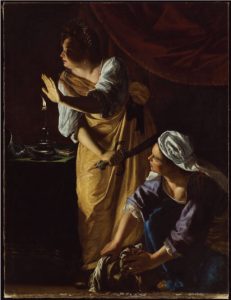Fierce Women: Artemisia Gentileschi and the Women Worthies
“I will show your Illustrious Lordship what a woman can do.”
-Artemisia Gentileschi (Italian, 1593-1654 or later), to Antonio Ruffo (Italian 1610/11-1678), a Sicilian nobleman and collector, 1649.
Featuring the baroque drama an extraordinary storytelling ability of Italian painter, Artemisia Gentileschi, Fierce Women builds off the heroine in one of her most important paintings, Judith and her Maidservant with the Head of Holofernes, ca. 1623-1625, which dramatizes one moment from the Biblical story of Judith, who beheaded the general of an invading army to save her city. This extraordinary painting is on loan to the Nelson-Atkins Museum from the Detroit Institute of Arts.
Tales of fierce women in myth and history, a select group of whom, including Judith, were called “women worthies,” were popular across Europe from the 1400s. Initially selected for their military prowess, their traits expanded during the baroque era to include intellectual and religious accomplishments. Visualized in prints, drawings, paintings and decorative arts, made by male and female artists alike, stories of women worthies promoted the idea of equal education and involvement of women in civic life as evidence of their intellectual and moral potential.
Historically there were nine women worthies evenly divided between Jewish, Christian, and ancient mythological stories. Over time, and especially during Artemisia Gentileschi’s era with the rise of contemporary female rulers, including Elizabeth I, Marie de Medici, and Anne of Austria, the canon expanded. Collectively, these individuals became living examples of powerful women, like Artemisia herself; all of whom used the canon of women worthies to actively reinforce their own positions.
Artemisia Gentileschi represented women worthies throughout her career, as did many of her near contemporaries. This exhibition features a selection of old master prints, drawings, and decorative arts featuring women worthies, allowing viewers the opportunity to gain a deeper appreciation and understanding of this provocative subject and the powerful role Artemisia Gentileschi played in developing them.
This focus exhibition is organized by the Nelson-Atkins Museum of Art with support from the Samuel H. Kress Foundation.
Programs
Name
An Evening of Fierce Women
Description
June 9, 2023
6–7 p.m. | Atkins Auditorium
Public $40 | Members $32 | Students $20
Join us for an evening of fierce women in music and painting. Just as Baroque painter Artemesia Gentileschi chose to tell the story of the brave Judith, period composers Elisabeth Jacquet de la Guerre, Barbara Strozzi, and Hildegard von Bingen also drew inspiration from women throughout history, immortalizing their stories in music.
Performed by Bach Aria Soloists: Founder/Artistic Director Elizabeth Suh Lane, Soprano Sarah Tannehill Anderson, Harpsichord Elisa Williams Bickers and featuring commentary by the senior Curator of European Arts Aimee Marcereau DeGalan, this evening will unite music and painting and celebrate the drama and splendor of the Baroque.
Image Caption:
Artemisia Gentileschi (Italian, 1593-1654 or later) Judith and Her Maidservant with the Head of Holofernes, ca. 1623-1625, oil on canvas, Unframed: 73 11/16 × 55 7/8 × 1 5/16 inches (187.2 × 142 × 3.3 cm), Framed: 90 1/2 × 72 1/2 × 8 1/2 inches, Gift of Mr. Leslie H. Green, Detroit Institute of Arts, 52.253
Some text in this exhibition refers to sexual assault. Like many people throughout history and today, Artemisia Gentileschi’s personal story was informed by experience with sexual assault. If you or someone you know is a survivor or a supporter of a survivor and you need help in Kansas City, we encourage you to reach out to MOCSA (Metropolitan Organization to Counter Sexual Assault) https://mocsa.org/

